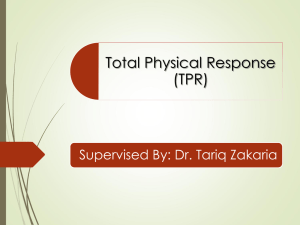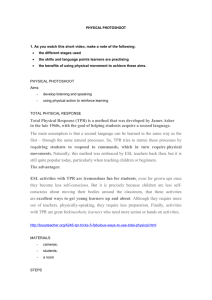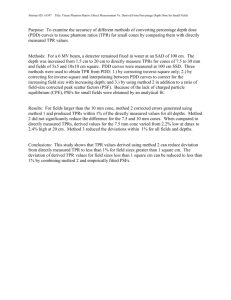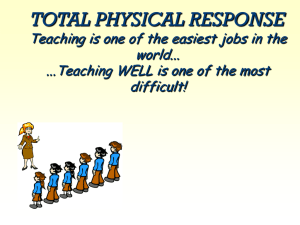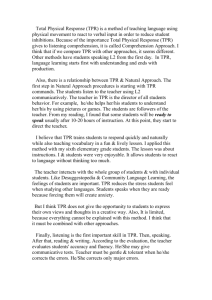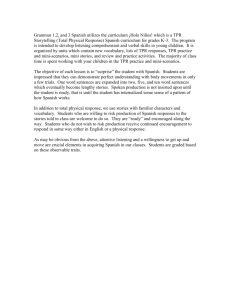Technical Method 406- TPR
advertisement
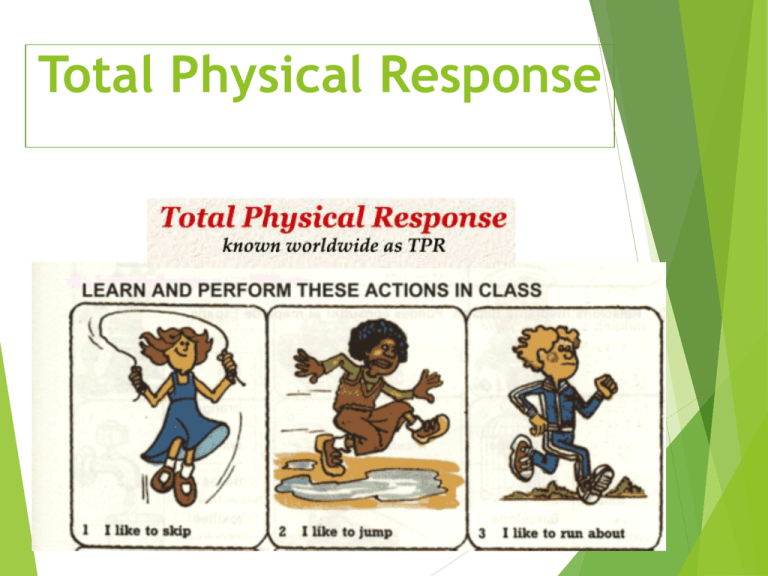
Total Physical Response By the end of this lecture, students should be able to: Develop an awareness about the history of the TPR. Recognize the nature of TPR. Define Total Physical Response. Recognize the methodology of TPR. Identify the advantages and disadvantages of the TPR. Form an outline about the TPR. Objective s of this lecture The History of the Total Physical Response •The total physical response (TPR) method was developed by psychologist James Asher (1974). This method is based on the principle that people learn better when they are involved physically as well as mentally. In TPR, students are required to respond nonverbally (physically) to a series of commands ,such as "Pick it up" and "Put it down". •TPR is based on the notion of first language acquisition when children “listen, watch and imitate” The nature of the TPR: Activities where a command is given in the imperative and the students obey the command is the main activity in TPR. Physical Response focus on listening skill which the students are required to listen what teachers comment and response immediately. Teacher’s role is to command the students through various imperative sentences. In the classroom the teacher and students take on roles similar to that of the parent and child respectively. Students must respond physically to the words of the teacher. The nature of the TPR: The emphasis in TPR is on listening comprehension until oral proficiency is developed. Careful choice of useful and communicative language at beginner level can make TPR activities entirely valid. Many learners respond well to kinesthetic activities and they can genuinely serve as a memory aid. Another excellent way to employ TPR is by the use of logical sequences of actions, also known as Gouin series, such as driving a car or taking a picture. The following example of : “Driving a Car” I take my car key in my hand. I walk to the car. I unlock the car door or I use my remote to unlock the door. I open the car door. I get into the car. I close the door. I put on the seat belt. I place the key in the ignition. I start the car. I take off Definition of the TPR: Total Physical Response is a language learning method based on the coordination of speech and action. TPR is based, first and foremost, on listening and this is linked to physical actions which are designed to reinforce comprehension of particular basic items. Objectives of the Total Physical Response: Teaching oral proficiency at a beginning level Using comprehension as a means to speaking Using action-based drills in the imperative form. The Methodology of the TPR: 1- The teacher gives a command and the students respond physically, the teacher ascertains students’ comprehension of the command. Initially, the teacher begins with simple commands such as: “Sit Down, Stand Up, Turn around and walk back to your seats.” 2- Once the students have practiced doing the commands a number of times, the students will give the commands, thus developing oral proficiency. 3- Then, teachers can employ pictures, objects, and for students to manipulate as they respond nonverbally. For example, the students are studying a unit on “emotions.” The teacher can pass out pictures of people displaying different emotions. “Raise the picture of the girl who seems sad.” 3-Commands become more complex as the students continue to develop listening comprehension and knowledge of subject matter. the assistance of pictures, students can be asked to categorize modes of transportation by land, water, or air, or they could be asked to rearrange pictures to show the life cycle of a butterfly. Advantages of the TPR: 1. Students enjoy getting up out of their chairs and moving around. 2. Simple TPR activities do not require a great deal of preparation on the part of the teacher. 3. TPR is aptitude-free, working well with a mixed ability class, and with students having various disabilities. 4. It is good for kinesthetic learners who need to be active in the class. 5. Class size need not be a problem, and it works effectively for children and adults. Disadvantages of the TPR: 1. The lack of reading and writing, become the main disadvantage in this approach. 2. This method limits the student’s creativity as it only required the students to response. 3. It is difficult to give instructions without using imperatives, so the language input is basically restricted to this single form. 4. It is quite difficult to see how this approach could extend beyond beginner level. 5. The relevance of some of the language used in TPR activities to real-world learner needs is questionable. 6. Moving from the listening and responding stage to oral production might be workable in a small group of learners but it would appear to be problematic when applied to a class of 30 students. Application : Typical Techniques: •Giving commands by the side of the teacher, and students should respond to those commands. •Kinesthetic •Usage activities. of pictures and objects. •Students don’t speak until ready. https://www.youtube.com/watch?v=1 Mk6RRf4kKs https://www.youtube.com/watch?v=K M-NFmpc6d8 https://www.youtube.com/watch?v=j6 De52Pzr8c The End Thank you for your participation

